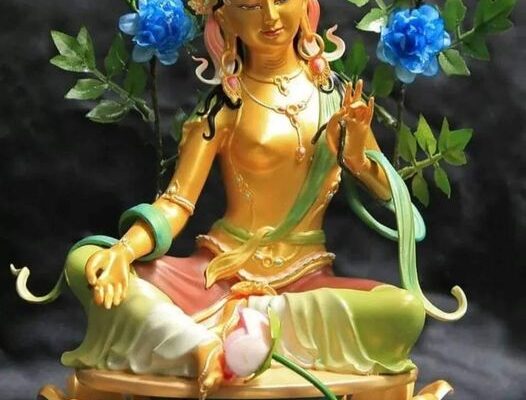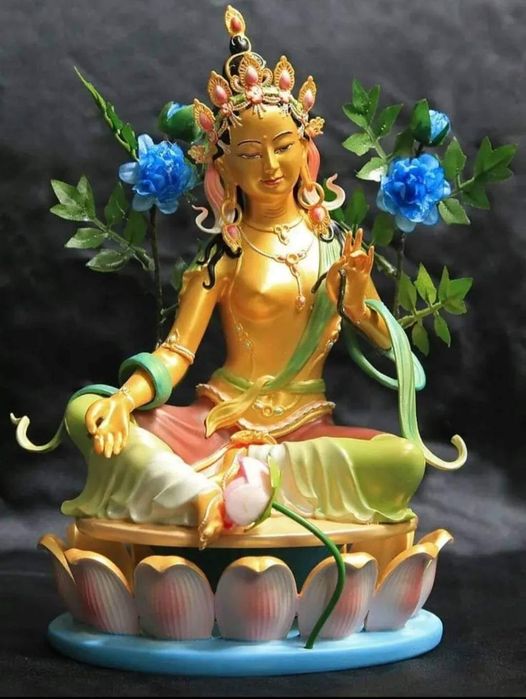
Tara – Buddhism
Tara – Buddhism
Evolution of Tara
I saw this lovely image of Tara. I have seen them but never thought about them seriously. This is the result of my study.
The origins of Tara can be traced back to ancient Indian mythology. She first emerged as a Hindu goddess associated with fertility and protection. However, as Buddhism began to flourish in India, Tara underwent a transformation and became integrated into Buddhist belief systems.

According to Buddhist lore, Tara’s evolution is intertwined with a tale of compassion and selflessness. Legend has it that a bodhisattva named Avalokiteshvara, out of deep compassion for all sentient beings, vowed to achieve enlightenment. However, upon witnessing the suffering of beings, he felt overwhelmed and shattered into a thousand pieces.
In response, Tara emerged from one of these shards, offering solace and support to Avalokiteshvara. She vowed to assist him in his quest for enlightenment and aid all beings in their spiritual journey.
Evolution of Tara in Buddhism
Tārā or Ārya Tārā, also known as Jetsun Dolma in Tibetan, is a female Buddha linked with Buddhist tantra practices in Tibetan Buddhism. She is called the “mother of liberation”. She stands for success in work and achievements.
Tārā is a tantric deity whose practice is used by followers of the Tibetan branch of Vajrayana Buddhism to develop their inner qualities and understand outer, inner and secret teachings about compassion and emptiness. Tārā is not found in the Japanese branch of Vajrayana Buddhism, Shingon.
Different forms of Tara in Buddhism
There is more than one form of Tārā. They have to do with different forms of the same quality. Bodhisattvas are often considered metaphors for Buddhist virtues.
Tara, often referred to as the Mother of Liberation, holds a significant place in Buddhist cosmology and spiritual practice. Across various traditions within Buddhism, Tara is revered as a bodhisattva, a compassionate being who postpones her own enlightenment to assist others in their journey towards liberation.
This mythological narrative underscores Tara’s compassionate nature and her role as a guide and protector in the Buddhist tradition. Over time, Tara’s symbolism and attributes evolved to reflect the diverse needs and aspirations of practitioners across different Buddhist schools and regions.
Tara is depicted in various forms, each representing different aspects of her compassionate presence. The most common forms of Tara are:
- Green Tara (Sitatara): Green Tara is perhaps the most widely recognized and revered form of Tara. She is depicted as a youthful and radiant figure seated gracefully with one leg extended, ready to spring into action to aid those in need. Green Tara embodies qualities such as compassion, protection, and swift action. She is often invoked for protection from fear and obstacles on the spiritual path.
- White Tara (Sitatara): White Tara is associated with longevity, healing, and serenity. She is depicted with seven eyes, symbolizing her ability to see the suffering of sentient beings and her readiness to offer assistance. White Tara is often invoked for healing physical and emotional ailments, as well as for blessings that promote longevity and spiritual well-being.
- Red Tara (Kurukulla): Red Tara is associated with magnetizing energy and the fulfillment of desires. She is depicted in a red hue, symbolizing her fiery and passionate nature. Red Tara is often invoked for attracting love, wealth, and success, as well as for overcoming obstacles hindering one’s progress on the spiritual path.
- Black Tara (Ekajati): Black Tara is a fierce and protective deity associated with the removal of obstacles and the destruction of negativity. She is depicted with a wrathful expression, wielding weapons and trampling upon demons and obstacles. Black Tara is often invoked for dispelling fear, overcoming obstacles, and subduing malevolent forces.
- Blue Tara (Nila Saraswati): Blue Tara is associated with the transmutation of anger and the attainment of wisdom. She is depicted in a deep blue hue, symbolizing her transformative power. Blue Tara is often invoked for pacifying conflicts, calming turbulent emotions, and nurturing the growth of wisdom and insight.
These different forms of Tara cater to the diverse needs and aspirations of practitioners, offering guidance, protection, and support on the spiritual journey.
Importance of Tara in Buddhism
We have Tara associated with Shaktipeeths in Hinduism. But Tara occupies a central place in Buddhist devotion and practice, revered for her compassionate nature and her swift response to the suffering of sentient beings. The importance of Tara in Buddhism can be understood through various dimensions:
- Compassionate Guidance: Tara embodies the compassionate spirit of Mahayana Buddhism, offering solace, guidance, and protection to practitioners navigating the challenges of samsara (the cycle of birth, death, and rebirth). Her presence serves as a reminder of the boundless compassion that underpins the Buddhist path.
- Swift Assistance: Tara is often depicted as a deity who responds swiftly to the calls of devotees. Whether invoked for protection, healing, or guidance, Tara is believed to intercede on behalf of practitioners with compassion and immediacy, offering support in times of need.
- Symbol of Feminine Wisdom: In a tradition where male deities often dominate the pantheon, Tara serves as a powerful symbol of feminine wisdom and compassion. Her presence challenges traditional gender norms and underscores the importance of embracing feminine qualities such as nurturing, empathy, and intuition on the spiritual path.
- Accessible Devotion: Tara’s popularity extends beyond monastic circles, attracting devotees from diverse backgrounds and walks of life. Her accessibility and approachability make her a beloved figure among lay practitioners, who turn to her for guidance and support in their daily lives.
- Emblem of Enlightenment: Tara’s vow to assist all sentient beings until they attain enlightenment symbolizes the bodhisattva ideal, wherein one aspires to achieve liberation not only for oneself but for all beings. By embodying this ideal, Tara inspires practitioners to cultivate compassion, altruism, and wisdom in their own lives.
In summary, Tara’s importance in Buddhism lies in her role as a compassionate guide, protector, and embodiment of enlightened qualities. Her presence resonates deeply with practitioners seeking solace, guidance, and inspiration on the spiritual path.
Some Top Temples Dedicated to Tara
- Tara Mandala Retreat Center (Pagosa Springs, Colorado, USA): Founded by Lama Tsultrim Allione, Tara Mandala is a renowned retreat center dedicated to the practice and teachings of Tara and other female deities. Nestled in the pristine mountains of Colorado, Tara Mandala offers retreats, workshops, and meditation programs focused on Tara’s wisdom and compassion.
- Yangleshö Cave Temple (Pharping, Nepal): Located near Kathmandu, Yangleshö Cave Temple is believed to be the sacred site where Guru Rinpoche (Padmasambhava) attained enlightenment with the blessings of Tara. The cave, adorned with sacred images and prayer flags, attracts pilgrims and practitioners seeking blessings and spiritual inspiration.
- Sankhu Vajrayogini Temple (Kathmandu Valley, Nepal): Although primarily dedicated to Vajrayogini, the ancient temple complex at Sankhu also houses a shrine dedicated to Tara. The temple, adorned with intricate carvings and sacred imagery, attracts devotees and pilgrims from around the world seeking Tara’s blessings and guidance.
- Palden Lhamo Temple (Lhasa, Tibet): Situated within the sacred precincts of the Jokhang Temple in Lhasa, the Palden Lhamo Temple is dedicated to the fierce protectoress deity Palden Lhamo, who is often associated with Tara.

very well researched
Kathmandu Nepal jaunga iss information k bad
Hey people!!!!!
Good mood and good luck to everyone!!!!!
https://vavada2.com/ всю правду о Максе Блэк и его приключениях в казино Вавада – обзор игрового салона, азартные игры и интересные подробности на сайте.
На официальном сайте казино вавада вы найдете лучшие игровые автоматы, бонусы и акции для азартных развлечений онлайн.
consists of the book itself
Отличный сайт! Всем рекомендую!аренда яхт в адлере